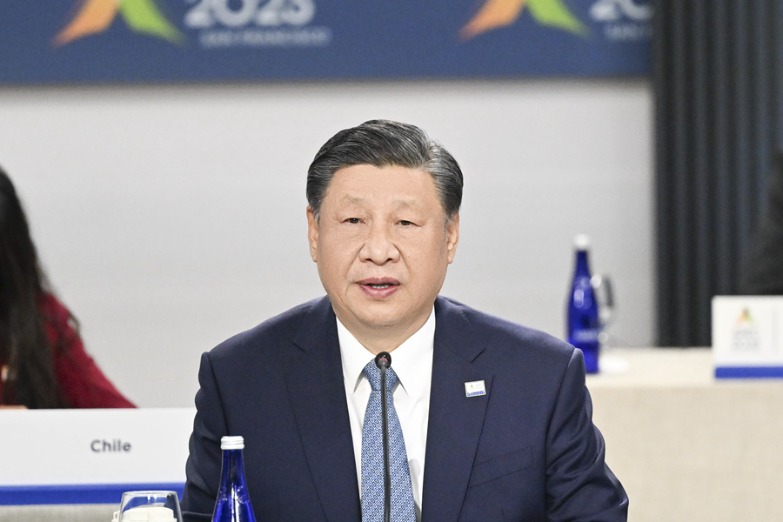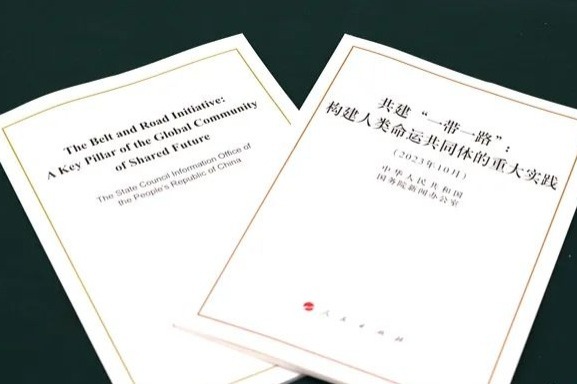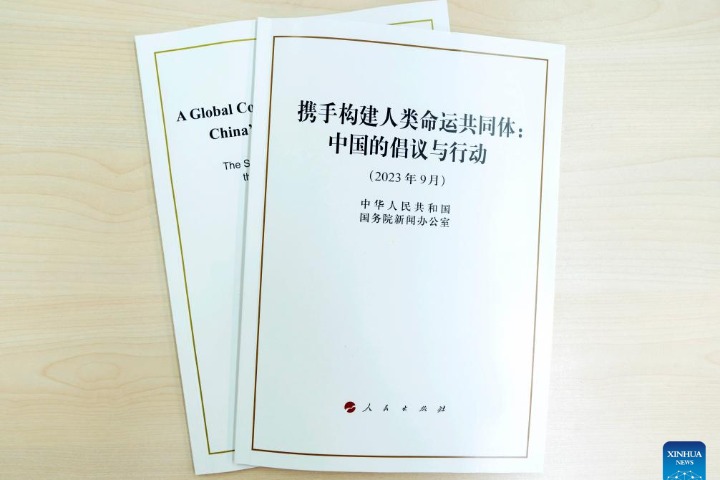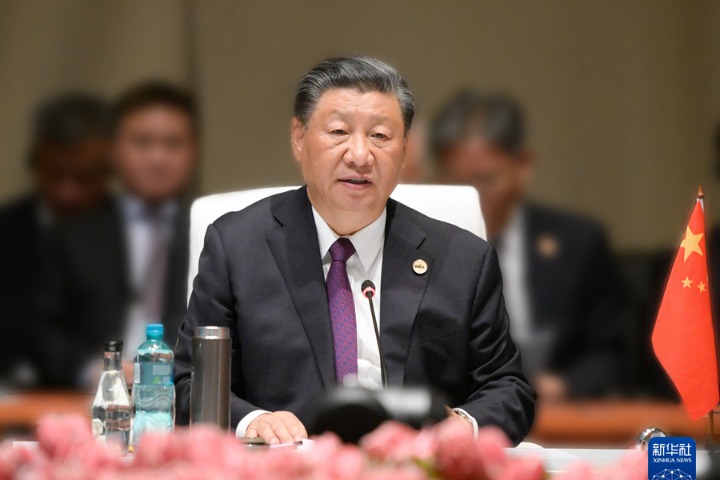中国应对气候变化的政策与行动(双语全文)
新华网 2021-10-27 16:52

国务院新闻办公室10月27日发表《中国应对气候变化的政策与行动》白皮书。

双语全文如下:
中国应对气候变化的政策与行动
Responding to Climate Change:
China’s Policies and Actions
(2021年10月)
中华人民共和国
国务院新闻办公室
The State Council Information Office of
the People’s Republic of China
October 2021
目录
Contents
前言
Preface
一、中国应对气候变化新理念
I. China’s New Responses to Climate Change
二、实施积极应对气候变化国家战略
II. Implementing a National Strategy of Actively Responding
to Climate Change
三、中国应对气候变化发生历史性变化
III. Significant Changes in China’s Response to Climate Change
四、共建公平合理、合作共赢的全球气候治理体系
IV. Building a Fair and Rational Global Climate Governance System
for Win-Win Results
结束语
Conclusion
前言
Preface
气候变化是全人类的共同挑战。应对气候变化,事关中华民族永续发展,关乎人类前途命运。
Climate change is a challenge for all of humanity. The sustainable development of the Chinese nation and the future of the planet depend on tackling it successfully.
中国高度重视应对气候变化。作为世界上最大的发展中国家,中国克服自身经济、社会等方面困难,实施一系列应对气候变化战略、措施和行动,参与全球气候治理,应对气候变化取得了积极成效。
China attaches great importance to its response to climate change. As the largest developing country in the world, China has adopted a number of policies, measures and actions to tackle climate change and take part in global climate governance, despite the difficulties this creates for its own economic and social development. These efforts have achieved positive results.
中共十八大以来,在习近平生态文明思想指引下,中国贯彻新发展理念,将应对气候变化摆在国家治理更加突出的位置,不断提高碳排放强度削减幅度,不断强化自主贡献目标,以最大努力提高应对气候变化力度,推动经济社会发展全面绿色转型,建设人与自然和谐共生的现代化。2020年9月22日,中国国家主席习近平在第七十五届联合国大会一般性辩论上郑重宣示:中国将提高国家自主贡献力度,采取更加有力的政策和措施,二氧化碳排放力争于2030年前达到峰值,努力争取2060年前实现碳中和。中国正在为实现这一目标而付诸行动。
Since the 18th National Congress of the Communist Party of China (CPC) convened in 2012, guided by Xi Jinping thought on eco-civilization and committed to the new development philosophy, China has made the response to climate change a higher priority in state governance. It has steadily reduced the intensity of its carbon emissions, reinforced the effort to achieve its Nationally Determined Contributions (NDCs), and maximized its drive to mitigate climate change. It has adopted green and low-carbon approaches in its economic and social development, and worked to build a modernized country in which humanity and nature coexist in harmony.
At the general debate of the 75th Session of the United Nations General Assembly on September 22, 2020, President Xi Jinping announced that China would scale up its NDCs by adopting more vigorous policies and measures, strive to peak CO2 emissions before 2030, and achieve carbon neutrality before 2060. China is taking pragmatic actions towards these goals.
作为负责任的国家,中国积极推动共建公平合理、合作共赢的全球气候治理体系,为应对气候变化贡献中国智慧中国力量。面对气候变化严峻挑战,中国愿与国际社会共同努力、并肩前行,助力《巴黎协定》行稳致远,为全球应对气候变化作出更大贡献。
As a responsible country, China is committed to building a global climate governance system that is fair, rational, cooperative and beneficial to all, and makes its due contribution to tackling climate change using its greatest strengths and most effective solutions. Confronted by the challenges of climate change, China is willing to work together with the international community to ensure the Paris Agreement delivers steady and lasting results, and make greater contribution to the global response.
为介绍中国应对气候变化进展,分享中国应对气候变化实践和经验,增进国际社会了解,特发布本白皮书。
The Chinese government is publishing this white paper to document its progress in mitigating climate change, and to share its experience and approaches with the rest of the international community.
一、中国应对气候变化新理念
I. China’s New Responses to Climate Change
中国把应对气候变化作为推进生态文明建设、实现高质量发展的重要抓手,基于中国实现可持续发展的内在要求和推动构建人类命运共同体的责任担当,形成应对气候变化新理念,以中国智慧为全球气候治理贡献力量。
China’s responses to climate change are an important part of its efforts to achieve eco-environmental progress and high-quality development. Based on the requirements of its internal sustainable development, and its due responsibility for building a global community of shared future, China has formulated new principles on tackling climate change and is contributing its solutions to global climate governance.
(一)牢固树立共同体意识
1. Building a Strong Sense of Common Community
坚持共建人类命运共同体。地球是人类唯一赖以生存的家园,面对全球气候挑战,人类是一荣俱荣、一损俱损的命运共同体,没有哪个国家能独善其身。世界各国应该加强团结、推进合作,携手共建人类命运共同体。这是各国人民的共同期待,也是中国为人类发展提供的新方案。
China advocates a joint effort to build a global community of shared future. The earth is the only home we have. Human beings share a common future in the face of the challenges presented by global climate change, and no country can make itself immune from the impact. Therefore, all countries should strengthen solidarity and cooperation, and build a global community of shared future together. This is China’s new vision for human development, in the common interest of all peoples.
坚持共建人与自然生命共同体。中华文明历来崇尚天人合一、道法自然。但人类进入工业文明时代以来,在创造巨大物质财富的同时,人与自然深层次矛盾日益凸显,当前的新冠肺炎疫情更是触发了对人与自然关系的深刻反思。大自然孕育抚养了人类,人类应该以自然为根,尊重自然、顺应自然、保护自然。中国站在对人类文明负责的高度,积极应对气候变化,构建人与自然生命共同体,推动形成人与自然和谐共生新格局。
China also advocates a community of harmony between humanity and nature. The Chinese people have always valued the idea that human beings are an integral part of nature and should follow the laws of nature. Industrial civilization, which has created massive material wealth, has also laid bare the growing tensions in the relationship between humans and nature. The ongoing Covid-19 pandemic has further stimulated profound reflection on that relationship. Mother Nature has nourished us, and we must treat her as our root, respect her, protect her, and follow her laws. Through a sense of responsibility to human civilization, China is making every effort to fight climate change, build a community of harmony between humanity and nature, and help foster a new relationship where humanity and nature can both live and prosper in harmony.
(二)贯彻新发展理念
2. Implementing the New Development Philosophy
理念是行动的先导。立足新发展阶段,中国秉持创新、协调、绿色、开放、共享的新发展理念,加快构建新发展格局。在新发展理念中,绿色发展是永续发展的必要条件和人民对美好生活追求的重要体现,也是应对气候变化问题的重要遵循。绿水青山就是金山银山,保护生态环境就是保护生产力,改善生态环境就是发展生产力。应对气候变化代表了全球绿色低碳转型的大方向。中国摒弃损害甚至破坏生态环境的发展模式,顺应当代科技革命和产业变革趋势,抓住绿色转型带来的巨大发展机遇,以创新为驱动,大力推进经济、能源、产业结构转型升级,推动实现绿色复苏发展,让良好生态环境成为经济社会可持续发展的支撑。
Actions are driven by philosophies. In this new development stage, China pursues a philosophy that development must be innovative, coordinated, green, open and shared, and accelerates the pace in creating a new development dynamic. Among the five axes of the new philosophy, green development is a necessary condition for sustainability. It represents the people’s aspiration for a better life, and is a key guide for China’s climate actions. China holds the view that clear waters and green mountains are invaluable assets, and that eco-environmental protection and improvement lead to greater productivity. Mitigating climate change reflects the overall global transition towards green and low-carbon living. China has abandoned its previous development model that damaged or even destroyed the eco-environment. Instead, following the current technological revolution and industrial trends, it has seized the opportunities created by green transition, transformed and upgraded its economic and industrial structure and energy mix through innovation, and achieved a green recovery from the Covid-19 pandemic. A better eco-environment is boosting China’s sustainable economic and social development.
(三)以人民为中心
3. Taking a People-Centered Approach
气候变化给各国经济社会发展和人民生命财产安全带来严重威胁,应对气候变化关系最广大人民的根本利益。减缓与适应气候变化不仅是增强人民群众生态环境获得感的迫切需要,而且可以为人民提供更高质量、更有效率、更加公平、更可持续、更为安全的发展空间。中国坚持人民至上、生命至上,呵护每个人的生命、价值、尊严,充分考虑人民对美好生活的向往、对优良环境的期待、对子孙后代的责任,探索应对气候变化和发展经济、创造就业、消除贫困、保护环境的协同增效,在发展中保障和改善民生,在绿色转型过程中努力实现社会公平正义,增加人民获得感、幸福感、安全感。
Climate change poses a severe threat to the economic and social development of all countries and to people’s lives and property. Therefore our responses affect the fundamental interests of all people. Mitigating and adapting to climate change are essential for increasing the people’s sense of eco-environmental gain, and will provide them with a fairer, more sustainable and safer environment that promotes higher quality and more efficient development. China puts people and lives first, and cherishes the life, value and dignity of every individual. Taking into full consideration the people’s aspiration for a better life, their expectation of a sound eco-environment, and their responsibility for future generations, China is pioneering a new approach that synergizes the efforts to fight climate change, develop the economy, generate employment, eliminate poverty, and protect the environment. It guarantees and improves people’s wellbeing through development, strives for social equity and justice in the process of green transition, and increases people’s sense of gain, happiness and security.
(四)大力推进碳达峰碳中和
4. Striving for Carbon Neutrality
实现碳达峰、碳中和是中国深思熟虑作出的重大战略决策,是着力解决资源环境约束突出问题、实现中华民族永续发展的必然选择,是构建人类命运共同体的庄严承诺。中国将碳达峰、碳中和纳入经济社会发展全局,坚持系统观念,统筹发展和减排、整体和局部、短期和中长期的关系,以经济社会发展全面绿色转型为引领,以能源绿色低碳发展为关键,加快形成节约资源和保护环境的产业结构、生产方式、生活方式、空间格局,坚定不移走生态优先、绿色低碳的高质量发展道路。
To achieve the goals of peaking carbon emissions and subsequent carbon neutrality is one of China’s major strategies, defined after careful consideration. This is a must-do in order to relieve the serious constraints imposed by resources and the environment on China’s economic growth, and to achieve sustainable development. It is also a solemn commitment towards building a global community of shared future. China has incorporated this decision into its overall economic and social development, adopting a holistic approach and balancing the relationships between economic growth and emissions reduction, between overall and regional interests, and between short, medium, and long-term growth. Led by the green economic and social transition, China is focusing on green and low-carbon development of the energy sector, and accelerating the formation of industrial structures, production modes, ways of work and life and spatial configurations that help to conserve resources and protect the environment. It is fully committed to high-quality development that prioritize eco-environmental protection and green and low-carbon way of life.
(五)减污降碳协同增效
5. Synergizing the Reduction of Pollution and Carbon Emissions
二氧化碳和常规污染物的排放具有同源性,大部分来自化石能源的燃烧和利用。控制化石能源利用和碳排放对经济结构、能源结构、交通运输结构和生产生活方式都将产生深远的影响,有利于倒逼和推动经济结构绿色转型,助推高质量发展;有利于减缓气候变化带来的不利影响,减少对人民生命财产和经济社会造成的损失;有利于推动污染源头治理,实现降碳与污染物减排、改善生态环境质量协同增效;有利于促进生物多样性保护,提升生态系统服务功能。中国把握污染防治和气候治理的整体性,以结构调整、布局优化为重点,以政策协同、机制创新为手段,推动减污降碳协同增效一体谋划、一体部署、一体推进、一体考核,协同推进环境效益、气候效益、经济效益多赢,走出一条符合国情的温室气体减排道路。
Carbon dioxide and other ordinary pollutants often come from the same sources, mainly from the burning and utilization of fossil fuels. Controlling the use of fossil fuels and consequently reducing carbon emissions have a lasting impact on the economic structure, energy mix, forms of transport, modes of production, and ways of life. It will boost high-quality development by pressing for the green transition of the economy; it will be conducive to mitigating climate change and the damage it causes to life, property, society, and the economy; it will facilitate the source control of pollution, achieving synergy between pollution and carbon reduction and improvement of the eco-environment; it will help conserve biodiversity and improve ecosystems.
China sees pollution prevention and control as an integral part of the response to climate change. Through structural adjustment, optimized configuration, policy synergy and innovative mechanisms, efforts to reduce pollution and carbon emissions are planned and carried out in tandem, and the performance assessment of the two is also conducted jointly. Balancing environmental, climate and economic gains, China has found a unique path to reducing greenhouse gas emissions that conforms to its actual conditions.

















 英语点津微信
英语点津微信 双语小程序
双语小程序